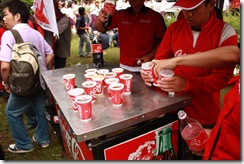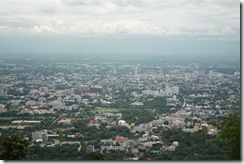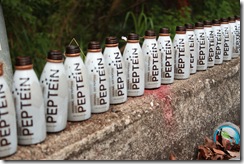Check out บุดด้า Buddha – ตัวอย่างหนัง เรื่องย่อ และ ข้อมูล ภาพยนตร์ Trailer, Synopsis and Movie Information | เมเจอร์ ซีนีเพล็กซ์ Major Cineplex
ลองทำโปสเตอร์ขนาด 2A0 ด้วย LaTeX + Beamer Class
ลง Windows 7 ไปแล้วยังไม่ได้ทดสอบโปรแกรมอีกหลายตัวเลย ทดสอบด้วยโค้ด LaTeX ของโปสเตอร์ AGU 2010 Fall Meeting ละกัน
ทำด้วย LaTeX และ Beamer Class Poster โดยไปดาวน์โหลดไฟล์ตัวอย่าง และ class มาดัดแปลงเองจากที่นี่ครับ http://www-i6.informatik.rwth-aachen.de/~dreuw/latexbeamerposter.php
ใครที่จะเอา code นี้ไป compile ก็คงคอมไพล์ไม่ผ่านเพราะต้องลง class / sty file ด้วยนะครับที่สำคัญ หลายๆ รูปในนี้ผมไม่ได้แนบไว้ให้ดาว์นโหลด ถ้าจะทดสอบก็ comment เฉพาะส่วนที่ insert รูปก็พอถูไถครับ
\documentclass[final,t]{beamer}
\mode<presentation>
{
% \usetheme{Warsaw}
% \usetheme{Aachen}
% \usetheme{Oldi6}
% \usetheme{I6td}
\usetheme{I6dv}
% \usetheme{I6pd}
% \usetheme{I6pd2}
}
% additional settings
\setbeamerfont{itemize}{size=\normalsize}
\setbeamerfont{itemize/enumerate body}{size=\small}
\setbeamerfont{itemize/enumerate subbody}{size=\small}
% additional packages
\usepackage{natbib}
\bibpunct{(}{)}{;}{a}{,}{,}
\usepackage{times}
\usepackage{amsmath,amsthm,amssymb, latexsym}
\usepackage{exscale}
%\boldmath
\usepackage{booktabs, array}
%\usepackage{rotating} %sideways environment
\usepackage[english]{babel}
\usepackage[latin1]{inputenc}
\usepackage[orientation=landscape,size=custom,width=178,height=118,scale=1.9]{beamerposter}
\listfiles
%\graphicspath{{figures/}}
% Display a grid to help align images
%\beamertemplategridbackground[1cm]
\title{\huge Spatially dependent turbulence and particle diffusion in an interplanetary magnetic flux rope}
\author[Krittinatham et al.]{\underline{Watcharawuth\ Krittinatham}$^1$, David\ Ruffolo$^{2,3}$, John W. Bieber$^4$}
\institute[NARIT]{$^1$National Astronomical Research Institute of Thailand, Chiang Mai, 50200, Thailand, e-mail: watcharawuth@narit.or.th \\
$^2$Department of Physics, Faculty of Science, Mahidol University and $^3$ Thailand Center of Excellence in Physics, CHE, Ministry of Education, Bangkok, 10400, Thailand \\
$^4$ Bartol Research Institute, Department of Physics and Astronomy, University of Delaware, 19716, USA}
%\date[Aug. 31 , 2007]{Aug. 31 , 2007}
% abbreviations
\usepackage{xspace}
\makeatletter
\DeclareRobustCommand\onedot{\futurelet\@let@token\@onedot}
\def\@onedot{\ifx\@let@token.\else.\null\fi\xspace}
\def\eg{{e.g}\onedot} \def\Eg{{E.g}\onedot}
\def\ie{{i.e}\onedot} \def\Ie{{I.e}\onedot}
\def\cf{{c.f}\onedot} \def\Cf{{C.f}\onedot}
\def\etc{{etc}\onedot}
\def\vs{{vs}\onedot}
\def\wrt{w.r.t\onedot}
\def\dof{d.o.f\onedot}
\def\etal{{et al}\onedot}
\makeatother
%%%%%%%%%%%%%%%%%%%%%%%%%%%%%%%%%%%%%%%%%%%%%%%%%%%%%%%%%%%%%%%%%%%%%%%%%%%%%%%%%%%%%%%%%%%%%%%%%%%%%%%%%%%%
%%%%%%%%%%%%%%%%%%%%%%%%%%%%%%%%%%%%%%%%%%%%%%%%%%%%%%%%%%%%%%%%%%%%%%%%%%%%%%%%%%%%%%%%%%%%%%%%%%%%%%%%%%%%
\begin{document}
\begin{frame}{}
\vspace{-2.5cm}
\begin{columns}
\begin{column}{.54\linewidth}
%%%%%%%%%%%%%%%%%%%%%%%%%%%%%%%%%%%%%%%%%%%%%%%%%%%%%%%%%%%%%%%%%%%%%%%%%%%%%%%%%%%%%%%%%%%%%%%%%%%%%%%%%%%%
\begin{block}{1.Introduction}
%\item The high energy particles originating outside the solar system called galactic cosmic rays (GCRs) strike the Earth’s %atmosphere from all directions and create the secondary GCRs that can be detected by ground-base detector e.g. neutron monitor
\vspace{-2.0cm}
\begin{columns}
\begin{column}{0.63\textwidth}
\begin{itemize}
\item Interplanetary Coronal Mass Ejections (ICMEs) are large-scale plasma bubbles and magnetic field structures expelled from the Sun into space.
\item Some ICMEs have large and smooth rotation of magnetic field lines, implying an “interplanetary magnetic flux rope (IMFR).”
\item When an IMFR sweeps past Earth, it deflects away some Galactic Cosmic Rays (GCRs) that would otherwise strike our planet from all directions, then the GCRs have a lower density inside the IMFR and the ground-based detectors experience the sudden drops in the signal called “Forbush Decreases (FDs).
\item \textcolor{blue!99.0}{We consider how GCRs fill the flux rope until the signal comes close to its ambient level.}
\end{itemize}
\end{column}
\begin{column}{0.22\textwidth}
\vspace{-1.0cm}
\begin{figure}
\centering
\includegraphics[width=1.0\textwidth]{Fig02_2stepsFD.eps}
%\caption{\footnotesize 1. Forbush Decrease in July 1982 detected by Deep River, Mt.Wellington, and Kerguelen neutron monitors to end of Forbush Decrease (from Cane $[1]$).}
\label{fig:Fig02_2stepsFD}
\end{figure}
\end{column}
\begin{column}{0.15\textwidth}
{\newline \footnotesize [\emph{left}] \textcolor{blue!99.0}{Figure 1}: Forbush Decrease and recovery to ambient intensity in July 1982 detected by Deep River, Mt.Wellington, and Kerguelen neutron monitors (from Cane [1]).}
\end{column}
\end{columns}
\end{block}
\begin{block}{2.Systematic physical processes of GCR transport}
\vspace{-2.5cm}
\begin{columns}
\begin{column}{0.46\textwidth}
\begin{itemize}
\item Parallel to the mean magnetic field: streaming and focusing, conserving the first adiabatic invariant.
\item Perpendicular to the mean magnetic field: gradient drift ($v_g$) and curvature drift ($v_c$).
\item The equation of the motion of the guiding center is $ d\mathbf{r}/dt = \mu v \mathbf{\hat{b}} + \mathbf{v}_g + \mathbf{v}_c$ where the pitch angle cosine is $\mu = \mathbf{p} \cdot \mathbf{B} / |\mathbf{p}||\mathbf{B}|$ and $\mathbf{p}$ is the particle’s momentum.
\item An analytic IMFR model developed by [2] in quasi-toroidal coordinates ($r,\phi,\theta$) relative to a circle of radius $R$, which is the axis of flux rope. A flux surface is defined by $r = a \cos(\phi/2)$, where $a$ is the radius of the flux surface at the apex of the rope ($\phi = 0$) (see Fig. 2).
\item Examples of some trapped-particle trajectories (Fig. 3a) in terms of $\mu$, and the distance from the Sun along the loop $Z = R(\pi-\phi)$, for varying initial $\mu_0$ at the apex. These trajectories exhibit magnetic mirroring.
\item The drift velocity across the flux rope surface, $v_n = (v_g + v_c)\hat{n}$, where $\hat{n}$ is the outward normal to the surface, yields an inflow rate (Fig.3b) and outflow rate (Fig.3c) averaged over the flux rope surface (averaged over $\theta$) as a function of $\mu$ and $Z$. The drifts across the flux rope boundary are predominantly inward along one leg of the loop and predominantly outward along the other.
\item During a Forbush decrease, this should contribute a unidirectional anisotropy and net flow of GCRs. The flow direction is determined by the poloidal field direction [2].
\end{itemize}
\end{column}
%\begin{equation}
%\mathbf{v}_g = \frac{\gamma m_0 (1-\mu^2)v^2}{2q} \left[ \frac{\mathbf{B} \times \nabla B}{B^3} \right].
%\end{equation}
%\begin{equation}
%\mathbf{v}_c = -\frac{\gamma m_0 \mu^2 v^2}{2 q B^2} \mathbf{B} \times \left[ \frac{\nabla B \times (\nabla %\times %\mathbf{B} ) }{B^2} – \frac{\nabla B}{B} \right].
%\end{equation}
\begin{column}{0.54\textwidth}
\begin{columns}
\begin{column}{0.62\textwidth}
\vspace{-1.5cm}
\begin{figure}
\centering
\includegraphics[width=0.70\textwidth]{Fig01_Orientation.eps}
%\caption{\footnotesize 3.Global analytic magnetic flux rope model developed by $[2]$.}
\label{fig:Fig01_Orientation}
\end{figure}
{\footnotesize [\emph{left}] \textcolor{blue!99.0}{Figure 2}: Global, analytic magnetic flux rope model $[2]$.}
\end{column}
\begin{column}{0.38\textwidth}
\vspace{-1.5cm}
\begin{figure}
\centering
\includegraphics[width=0.9\textwidth]{f6.eps}
%\caption{\footnotesize 4.(a) Particle trajectories in terms of $\mu$, and $Z$ (b) In?ow rate and (c) out?ow rate averaged over the surface of the ?ux rope(averaged over $\theta$) as a function of $\mu$ and Z in unit AU km s$^{?1}$ .}
\label{fig:resultsdriftgcrs}
\end{figure}
\end{column}
\end{columns}
\vspace{0.5cm}
{\footnotesize [\emph{right}] \textcolor{blue!99.0}{Figure 3}: (a) Particle trajectories in terms of $\mu$, and $Z$ (b) Inflow rate and (c) outflow rate averaged over the surface of the flux rope(averaged over $\theta$) as a function of $\mu$ and $Z$ in units of AU km s$^{-1}$.}
\end{column}
\end{columns}
\end{block}
%%%%%%%%%%%%%%%%%%%%%%%%%%%%%%%%%%%%%%%%%%%%%%%%%%%%%%%%%%%%%%%%%%%%%%%%%%%%%%%%%%%%%%%%%%%%%%%%%%%%%%%%%%%%
\begin{block}{3.Stochastic processes and spatial dependence of turbulence}
\vspace{-2.5cm}
\begin{columns}
\begin{column}{0.75\textwidth}
\begin{itemize}
\item Magnetic turbulence described by the $2D$+Slab model of [3]: $\mathbf{B} = B_m \hat{z} + \mathbf{b}(x,y,z) = B_m \hat{z} + \mathbf{b}_{2D}(x,y) + \mathbf{b}_{SL}(z)$, where $B_m \hat{z}$ is the mean magnetic field, and $\mathbf{b}_{2D}(x,y)$ and $\mathbf{b}_{SL}(z)$ are transverse fluctuation fields.
\item Field Line Random Walk (FLRW): Particles diffuse because they undergo no parallel scattering and are tied to a field line, which undergoes a random walk.
\item The Non-Linear Guiding Center (NLGC)theory is based on the \textcolor{blue!99.0}{FLRW, parallel diffusion along the mean field}, and \textcolor{blue!99.0}{diffusion of guiding center} [4,5].
\item Pitch angle scattering: particles scattered by parallel force $\mathbf{F}_{||} = q \mathbf{v}_{\perp} \times \mathbf{b}$, which randomly changes the pitch angle.
\item Assumption: flux rope originally had uniform turbulence, but during expansion and stretching of the ICME, at relative speeds faster than the Alfv\’en speed, turbulence properties became non-uniform.
\item Assumption: 2D correlation length $l_{2D}$, expands as a perpendicular length scale proportional to the flux rope radius: $l_{2D} = l_{2D,Apex}\cos(\phi/2)$.
\item Assumption: Slab correlation length, $l_{SL}$, is stretched along with the loop like the field line winding: $l_{SL} = l_{SL,Apex} / \cos(\phi/2)$.
%\begin{equation}
%D_{\perp} = \frac{D_{SL} + \sqrt{D_{SL}^2 + 4D_{2D}^2} }{2},
%\end{equation}
%where $D_{\perp}$, $D_{SL}$, and $D_{2D}$ are FLRW perpendicular, 2D and slab diffusion coefficients. \\
%\begin{figure}[h]
% \centering
% \includegraphics[width=0.5\textwidth]{FigCh03_FluctuationField.eps}
% \caption{\tiny Illustration of (a) the field line fluctuation of winding magnetic field line in a magnetic flux rope and the particle motion gyrate around fluctuated field line and (b) the magnetic field line random walk perpendicular displacements $\Delta x$ and $\Delta y$}
% \label{fig:FigCh03_FluctuationField}
% \end{figure}
\item Assumption: Spatial dependence of turbulent energy density $b^2$ is related to local expansion/stretching of the volume, giving $\mathbf{b} = \mathbf{b}_{Apex} / \sqrt{\cos(\phi/2)}$.
\end{itemize}
\end{column}
\begin{column}{0.25\textwidth}
\begin{figure}
\centering
\includegraphics[width=0.80\textwidth]{FigCh03_NLGC.eps}
%\caption{\footnotesize 2.The basis of NLGC theory.}
\label{fig:FigCh03_NLGC}
\end{figure}
{\footnotesize \textcolor{blue!99.0}{Figure 4}: The basis of NLGC theory.}
\end{column}
\end{columns}
\end{block}
\end{column}
%%%%%%%%%%%%%%%%%%%%%%%%%%%%%%%
\begin{column}{.42\linewidth}
\begin{block}{4.Results}
\begin{itemize}
\item We use an energy ratio $E_{SL}/E_{2D} = 10.0/90.0$, $\langle b_{SL}^2 \rangle/ \langle b_{2D}^2 \rangle = 0.18$, $b^2/B_m^2 = 0.05$, $l_{2D,Apex} = 0.006$ AU, and $l_{SL,Apex} = 0.003$ AU.
\item The particles’ perpendicular mean free path and diffusion coefficients calculated from the NLGC theory compared with the results from the FLRW theory are shown in Fig.5.
\item We simulate GCR motion by initially placing the guiding centers of protons of 1 GeV kinetic energy at flux rope surface. Then we trace the trajectories due to systematic and stochastic processes. as mentioned before. The results are shown in Figs. 6 and 7 by plotting the positions of particle guiding centers in a cross-section of the flux rope ($a-\theta$ space), integrating over the entire rope (integrate over $\phi$) as a function of time.
\end{itemize}
\vspace{-2.25cm}
\begin{columns}
\begin{column}{0.33\textwidth}
\begin{figure}
\centering
\includegraphics[width=1.0\textwidth]{Fig_compare_lambda_vary_phi.eps}
%\caption{\footnotesize 5. a) Comparison of parallel diffusion mean free path calculated from NLGC theory at various flux surface $a = 0.0$, $0.05$, and $0.10$ AU. b) Show the perpendicular mean free path calculated from NLGC theory (solid lines) and FLRW theory (dashed lines) comparison at various $a$, and c) comparison of perpendicular diffusion coefficients.}
\label{fig:FigCh03_NLGC}
\end{figure}
\end{column}
\begin{column}{0.33\textwidth}
%\begin{figure}
% \centering
% \includegraphics[width=1.0\textwidth]{Fig_compare_lambda_vary_theta.eps}
% \caption{a) Comparison of parallel diffusion mean free path calculated from NLGC theory at various flux surface $a = 0.0$, $0.05$, and $0.10$ AU. b) Show the perpendicular mean free path calculated from NLGC theory (solid lines) and FLRW theory (dashed lines) comparison at various $a$, and c) comparison of perpendicular diffusion coefficients.}
% \label{fig:FigCh03_NLGC}
% \end{figure}
\begin{figure}
\centering
\includegraphics[width=1.0\textwidth]{Results_DriftOnly.eps}
%\caption{\footnotesize 6. The position of guiding center in cross-section of flux rope as the results of simulation with systematic process (drifts and first adiabatic invariant) only.}
\label{fig:driftonly}
\end{figure}
\end{column}
\begin{column}{0.33\textwidth}
\begin{figure}
\centering
\includegraphics[width=1.0\textwidth]{Results_Drift_Diffusion.eps}
%\caption{\footnotesize 7. Same as Fig.6 but adding stochastic process in the simulation.}
\label{fig:driftdiff}
\end{figure}
\end{column}
\end{columns}
{\footnotesize [\emph{left}] \textcolor{blue!99.0}{Figure 5}: (a) Comparison of parallel diffusion mean free path calculated from quasilinear theory at various flux surfaces $a = 0.0$, $0.05$, and $0.10$ AU. (b) Perpendicular mean free paths calculated from FLRW (solid lines) and NLGC theory (dashed lines). Because the difference is not great, and FLRW is much faster to compute, we employ this theory in the simulations.} \newline
{\footnotesize[\emph{center}] \textcolor{blue!99.0}{Figure 6}: The position of guiding centers in integrated cross-section of flux rope at various times from a simulation with systematic processes only (streaming, focusing, and drifts).} \newline
{\footnotesize [\emph{right}] \textcolor{blue!99.0}{Figure 7}: Same as Fig.6 but adding stochastic processes to the simulation.}
\end{block}
%%%%%%%%%%%%%%%%%%%%%%%%%%%%%%%%%%%%%%%%%%%%%%%%%%%%%%%%%%%%%%
\begin{block}{5.Conclusions}
\begin{itemize}
\item The drifts alone cannot transport the GCRs into the inner portion of the rope.
\item The drifts alone do not are not sufficient to fill the flux rope with GCRs to come close to an ambient level over a time scale of several hours.
\item In a weak turbulence environment such as that inside a magnetic cloud, the particles’ perpendicular mean free path and perpendicular diffusion coefficient can be similar for FLRW \& NLGC theories (see also [5]).
\item The perpendicular mean free path at the center of the IMFR is short, and becomes longer away from the flux rope axis.
\item The parallel mean free path is very long in the loop leg regions, and then shorter at the flux rope’s apex.
\item The perpendicular mean free path is short at the loop leg regions, and then longer at the flux rope’s apex.
\item When adding stochastic processes such as perpendicular diffusion and pitch angle scattering, the particle is able to travel into the center region of an IMFR.
\end{itemize}
\end{block}
\vspace{-2.0cm}
\begin{columns}
\begin{column}{0.60\textwidth}
\begin{block}{6.References}
%\begin{enumerate}
{\small
[1] H. V. Cane 2000, \emph{J. Geophys. Res.}, 98,3509 \newline
[2] W. Krittinatham, D. Ruffolo 2009, \emph{Astrophys. J.}, 704, 831 \newline
[3] W. H. Matthaeus \etal 1995, \emph{Phys. Rev. Lett.}, 75, 2136 \newline
[4] W. H. Matthaeus \etal 2003, \emph{Astrophys. J.}, 590, L53 \newline
[5] D. Ruffolo \etal 2008, \emph{Astrophys. J.}, 686, 1231
}
%\end{enumerate}
\end{block}
\end{column}
\begin{column}{0.36\textwidth}
\begin{block}{Acknowledgements}
This work is partially supported by the Thailand Research Fund and NASA grant NNX07AH73G.
\end{block}
\end{column}
\end{columns}
%\bibliographystyle{alpha}
%\bibliography{poster.bib}
%\begin{thebibliography}{}
%\bibitem[Burlaga et al (1990)]{BurlagaEA90} Burlaga, L.F., Lepping, R.P.,\& Jones, J.A. 1990, \emph{Physics of Magnetic Flux Rope}, (Washington, DC.), 373
%\bibitem[Cane (2000)]{Cane00} Cane, H.V. 2000, \emph{Space Sci. Rev.}, 93, 55
%\bibitem[Droge (2000)]{Droge00} Dr\”{o}ge, W., 2000, \emph{Astrophys. J.}, 537, 1073
%\bibitem[Earl (1994)]{Earl94} Earl, J.A. 1994, \emph{Astrophys. J.}, 425, 331
%\bibitem[Krittinatham \& Ruffolo (2009)]{KrittinathamRuffolo09} Krittinatham, W., \& Ruffolo, D. 2009, \emph{Astrophysical J.}, 704, 831
%\bibitem[Matthaeus et al (2007)]{MatthaeusEA07} Matthaeus, W.H., Bieber, J.W., Ruffolo, D., Chuychai, P., \& Minnie, J. 2007, \emph{Astrophys. J.}, 667, 956
%\bibitem[Matthaeus et al (2003)]{MatthaeusEA03} Matthaeus, W.H., Qin, G., Bieber, J.W., \& Zank, G. 2003, \emph{Astrophys. J.}, 590, L53
%\bibitem[Matthaeus et al (1995)]{MatthaeusEA95} Matthaeus, W.H., Gray, P.C., Pontius, D.H., \& Bieber, J.W. 1995, \emph{Phys. Rev. Lett.}, 75, 2136
%\bibitem[Meyer et al (1956)]{MeyerEA56} Meyer, P., Parker, E.N., \& Simpson, J.A. 1956, \emph{Phys. Rev.}, 104(3), 768
%\bibitem[Russell \& Mulligan (2002)]{RussellMulligan02} Russell, C.T., Mulligan, T. 2002, \emph{Planet. \& Space Sci.}, 50, 527
%\end{thebibliography}
\end{column}
\end{columns}
\end{frame}
\end{document}
%%%%%%%%%%%%%%%%%%%%%%%%%%%%%%%%%%%%%%%%%%%%%%%%%%%%%%%%%%%%%%%%%%%%%%%%%%%%%%%%%%%%%%%%%%%%%%%%%%%%
%%% Local Variables:
%%% mode: latex
%%% TeX-PDF-mode: t
%%% End:
ข้อดีคือไฟล์ขนาด Double A Zero นี่ถ้าทำด้วย Power Point จะสร้างไม่ได้เนื่องจากลิมิตของโปรแกรม ถ้าจะทำด้วย Illustrator Class โปรแกรมอย่าง Inkscape หรือ Adobe Illustrator ก็จะ “เปลือง Ram” มากครับ ดีไม่ดีนี่ Laptop ช้าๆ อาจจะทำไม่ได้เลยด้วยซ้ำ ดังนั้นการเขียนด้วย LaTeX จึงเป็นทางออกที่ดีที่สุดเนื่องจากเป็นการทำงานใน text mode ธรรมดาเท่านั้น แต่ต้องใช้ “จินตนาการ” หรือ คอมไพล์ code ในสมองเอาเองว่ามันจะออกมาเป็นอย่างไร แล้วคอมพิวเตอร์จะทำงานหนักอีกทีตอน compile file LaTeX เป็น dvi, ps หรือ pdf file ครับ
นี่คือไฟล์ที่คอมไพล์เสร็จแล้ว (>_<)>
จากนั้นก็เอาไปส่งร้านรับพิมพ์โปสเตอร์ตกตารางเมตรละ 800 บาท สำหรับงาน Indoor Poster เจ้าของร้านเห็นแล้วตกใจว่าใช้โปรแกรมกับเครื่องอะไรทำ ถึงได้ทำไฟล์ได้ใหญ่มโหฬารขนาดนี้โดยเครื่องไม่อืด ไม่ Hang (ใช้ iMac อ่ะเปล่า?) ผมก็บอกว่าใช้ laptop , Windows 7 Ram 3 GB เท่านั้นเอง เหอๆ (^_^!) แต่มันเหนื่อยที่การค่อยคอมไพล์ แล้วถ้าไม่ถูกใจก็ต้องมาปรับค่าใน code ใหม่แล้วคอมไพล์อีกนั่นแหละ
ไฟล์ theme ที่ต้องใช้คือไฟล์นี้ครับ http://www-i6.informatik.rwth-aachen.de/~dreuw/download/beamerthemeI6dv.sty
มองท้องฟ้าในผนังตึก

คงจะมีแน่เมืองใหญ่แบบนี้แหละมั้ง ที่เราสามารถมองท้องฟ้าด้วยภาพสะท้อนจากผนังตึก(ที่เป็นกระจก) ตอนที่ถ่ายรูปนี้ออกมา มีความรู้สึกเหมือน "โลกในจิต" ของ คุโรซากิ อิจิโกะ พระเอกเรื่อง Bleach เป็นโลกเอียงๆ กระเท่เร่ กลับหัวหลับหาง มีตึกวางนอนๆ พิลึกๆ แบบนี้นี่แหละ
หนีความวุ่นวายจาก ฮิห้า มาอยู่ multiply นี่ก็ดีนะ upload รูปง่ายดี
ผ่านไปเดือนกว่าๆ Referee ก็ให้ความเห็นเกี่ยวกับงานวิจัยที่จะตีพิมพในวารสารมาแล้ว ค่อนข้างดีทีเดียว เขาชมมาด้วยนิดหนึ่ง แล้วก็มีจุดที่อยากให้แก้ไข เพิ่มเติม ตอนนี้ก็ต้องทำการแก้ไขแล้วก็เตรียมตอบ Referee
ส่วนวิทยานิพนธ์ บทที่หนึ่ง Introduction เสร็จเป็นที่เรียบร้อยแล้ว แค่ Introduction เราก็ซัดไปแล้ว 21 หน้า 0_o แล้วทฤษฎี กับพวกผลการทดลอง จะกี่หน้าดีเนี่ย เล่มวิทยานิพนธ์หนาเตอะแน่ๆ งานข้าพเจ้า >_< อ้าก…….
รับน้องขึ้นดอย ม.เชียงใหม่ 4 กค.
รับน้องขึ้นดอย มหาวิทยาลัยเชียงใหม่
เมื่อวันเสาร์ที่ 4 ก.ค. ที่ผ่านมา ผมก็มีโอกาสไปรับน้องขึ้นดอยของ มช. ในโอกาสที่เป็นวันหยุดยาว ทำให้การติดสินใจ “ขึ้นเหนือ” รอบนี้ง่ายแทบไม่ต้องคิดเลย
การรับน้องขึ้นดอย โดยทั่วไปแล้วก็คือการ “พานักศึกษาชั้นปีที่หนึ่ง ขึ้นไปนมัสการพระธาตุดอยสุเทพ” และวิธีการที่จะไปถึงวัดพระธาตุได้ ก็ต้อง “เดิน” (หรือคณะไหนจะวิ่งก็แล้วแต่สมัครใจ — เอ๊ะหรือจิตวิทยาหมู่??) เอาเถอะ แต่สุดท้ายมันก็ไม่มีอะไรหนักหนาสาหัสไปมากกว่าการเดินขึ้นให้ถึงยอดดอยล่ะนะ ซึ่งแต่ละคณะก็มีวิธีบริหารจัดการ “คน” ต่างกันออกไป
บ้างก็เดินสบายๆ บ้างก็มีพี่วินัยมาคุมแถว บ้างก็มีสตาฟฟ์วิ่งมาคุมแถว ตะโกนสั่งการให้ขึ้นอย่างเป็นระเบียบเรียบร้อย ที่เหลือก็เป็นรุ่นพี่ทั้งที่เรียนอยู่หรือจบไปแล้วกลับมาร่วมเดินด้วย แต่ก็ตามกำลังความสามารถ ใครไหวก็เดินขึ้นและลง บ้างก็เดินขึ้นอย่างเดียว บ้างก็นั่งรถขึ้นแล้วเดินลง! บ้างก็นั่งรถขึ้นทั้งขึ้นและลง!!??
งานเริ่มต้นในตอนเช้า ของวันเสาร์แรกของเดือนกรกฎาคมครับ(อาจจะเลื่อนได้แล้วแต่สถานการณ์พิเศษ) ซึ่งถูกกำหนดไว้อย่างนี้มาหลายปีแล้ว ตั้งแต่พิธีการและพิธีศาสนา ก็จะค่อยๆ ปล่อยขบวนนักศึกษาขึ้นไปตามลำดับ
ก่อนเดินรุ่นพี่คณะวิทยาศาสตร์ “มนต์วิดยา” ให้น้องก่อน
ทีมพยาบาล(ภาควิชาเคมี) พร้อม!!
สตาฟฟ์วิ่ง(สตาฟฟ์คุมแถวและความเรียบร้อย) พร้อม!!
ปี 1 พร้อม!!
ออกเดินทาง(ในภาพ ก็รุ่นพี่ภาควิชาเคมีอุตสาหกรรม)
ช่วงเดินผ่านหน้าสวนสัตว์เชียงใหม่ สังเกตว่าที่ยาวอ้อมไปด้านหลังก็คือคณะวิทยาศาสตร์ทั้งสิ้น (แถวยาวมากๆ)
ชาวคณะที่ไปด้วยกัน
ช่วงสามกิโลเมตรแรกนี่เหนื่อยสุดๆ เลยครับ นึกว่าจะเดินไม่ถึงยอดด้วยซ้ำ ในกลุ่มเริ่มคุ้ยกันแล้วว่าโบกรถไปขับรถยนต์ขึ้นมาดีไหม แต่จนแล้วจนรอดก็ไม่ถอยหลังกันอยู่ดี พอผ่านจุดแจงน้ำที่วังบัวบานของสหกรณ์ มช. ก็ค่อยใจชื้นขึ้น จุดพักและแจกน้ำ ดูเหมือนจะมากกว่าเมื่อหลายปีก่อนมาก แถมสปอนเซอร์ยังมากขึ้นอีกต่างหาก
ตั้งแต่
โบตันมินท์บอล กับแท่งน้ำแข็ง
ที่หน้าสำนักงานไฟป่าดอยสุเทพก็มี….
โค้ก แจกฟรีๆ เลยงานนี้
พี่ๆ เจ้าหน้าที่ และรถพยาบาลที่เตรียมพร้อมเสมอ แต่ก็หวังว่าคงไม่มีใครเป็นอะไรมาก
ผ่านช่วงนี้ไปเริ่มกำลังใจมาแล้วครับเพราะมาได้เกือบครึ่งทางแล้ว น้ำท่าก็บริบูรณ์ดี เรียกเหงื่อที่เสียไปคืนได้เยอะ เรียกว่าถ้าอดทนเดินผ่านมาถึงจุดนี้ได้ ก็ไม่มีท้อแล้วล่ะ
แวะถ่ายภาพวิวทิวทัศน์เมืองเชียงใหม่
ที่จุดชมวิว จะมีซุ้มแจกเครื่องดิ่มของซอยเปปไทด์
ไม่รู้ว่ามีใครกินหมดขวดบ้างหรือเปล่า แต่นี่คือขวดทีวางไว้ข้างทาง (สุสานซอยเปปไทด์ชัดๆ) งานนี้นักธุรกิจเก็บขวดพลาสติค-ขวดแก้วไปขายที่ร้านรับซื้อ Recycle หวานเลยล่ะครับ เงินทั้งนั้น
จริงๆ ก็มีพวกถุงดำเตรียมไว้รองรับขยะนะ แต่บางทีก็ติดตั้งกระจุกกันเกินไปเหมือนกัน ทำให้บางที่เต็มไปด้วยขยะ บางที่ถุงขยะก็แทบจะว่างเปล่า
ถึงหอดูดาวสิรินธรแล้ว อีก 3 กิโลเมตร ก็ถึงยอดดอยแล้ว
ช่วงขาขึ้นรถติดเป็นตังเมเลยทีเดียว
นี่แหละโค้งสุดท้าย โค้งหักศอกสุดแสนจะลาดชันก่อนถึงวัดพระธาตุล่ะ
ที่โค้งนี้(โค้งขุนกันชนะนนท์) เป็นประเพณีที่ว่า ไม่ว่าก่อนหน้านี้คณะไหนจะเดินจะวิ่งหรือจะค่อยๆย่าง(หมายถึงค่อยๆย่างเท้าอย่างช้าๆ)ขึ้นมา เมื่อมาถึงโค้งนี้จะวิ่งขึ้นเป็นส่งท้าย บ้างก็เรียกว่าเป็นโค้ง Spirit แต่มักเรียกด้วยการประชดว่าโค้ง Stupid (-_-!) ซะงั้น
สภาพหักศอกของโค้งขุนกันฯ และการวิ่งแสดงสปิริตของคณะศึกษาศาสตร์ครับ
แต่จะเป็นโค้งอะไรก็แล้วแต่ สุดท้ายเราก็วิ่งขึ้นกันทั้งนั้น อะเหอๆ ถ้าทางที่ผ่านมาหมายถึงการเรียนคอร์สเวิร์ก โค้งนี้ก็คงหมายถึงวิทยานิพนธ์ โปรเจค หรืองานที่ทำให้เรียนจบล่ะนะ ต้องออกแรงกันมากหน่อย (^_^)>
บรรยากาศการวิ่งของน้องปี 1 คณะวิทยาศาสตร์
น่าเสียดายที่ปีนี้ไม่มีการแสดงที่ลานจอดรถ พอน้องวิ่งขึ้นเสร็จเราก็โบกรถสองแถวกลับลงมา (หมดแรงแล่ว -_-) สังเกตว่าปีนี้สปอนเซอร์ ของแจกมากขึ้น ขยะก็มากขึ้น การบริหารจัดการขยะจึงเป็นสิ่งที่ท้าทายสโมสรนักศึกษา/มหาวิทยาลัยมากๆ
กรุงเทพฯ ยามเช้า
หลังจากที่ไม่ได้อัพเดทบล๊อกมานานเกือบสองเดือน
ด้วยความวุ่นวายของการเขียน paper ที่จะนำไปตีพิมพ์ในวารสารต่างประเทศเพื่อเป็นผลงานเสนอจบปริญญาเอก รวมทั้งการเขียนวิทยานิพนธ์ (ตอนนี้บทแรกยังอยู่ระหว่างการตรวจแก้อยู่เลย T_T เหลืออีกตั้ง 6 บท) ทำให้ไม่มีเวลาเขียนอะไรเป็นเรื่องเป็นราวมากนัก
เมื่อวานนี้เห็นทีได้ฤกษ์ไปซื้อกล้อง Canon EOS 450D มา เป็นกล้อง Single Lens Deflect ตัวแรกในชีวิต แทน Olympus C730uz ที่ใช้มานานเกือบ 6 ปี หลังจากที่เล็งกล้อง DSLR แบบนี้มานาน 2 ปี XD (แหมเล็งนานจริงๆ) สะสมเงินเก็บจนได้มากกว่าราคาของประมาณห้าเท่าจึงค่อยไปซื้อมาใช้ การกำหนดกติกาการซื้อของให้ตัวเองแบบนี้ทำให้เราไม่ใช่คนที่กะจะซื้ออะไรก็ซื้อเลยจนหมดไม่มีเงินเก็บไม่มีเงินสำรอง ถ้าทำแบบนี้ก็จะมีเงินเก็บเหลือไว้กันเหนียวอีก 80% เลยทีเดียว (ไม่อดตายแน่นอน)
เหตุที่เลือกใช้กล้องแบบนี้ก็เพราะว่าประทับ ใจการปรับแต่งค่าของกล้อง (เช่น White Balance, F, Shutter Speed, Aperture ฯลฯ ที่ง่ายมากๆ ไม่ต้องมานั่งกดเปลี่ยนเมนูซับซ้อนเหมือนในกล้องคอมแพค แถมมีช่วงเลนส์(แพงๆ T_T) ให้เลือกใช้ตามความต้องการของเรา
เช้านี้ก็เลยลองซักเปรี้ยงหลายเปรี้ยง แล้วคัดภาพที่ค่อนข้างชอบที่สุดมา
เป็น ภาพกรุงเทพฯ เมื่อเช้านี้ ถ่ายด้วยเลนส์ Kit Canon 18-55mm F/10 ISO-800 เปิดหน้ากล้อง 1/512 วินาที ระยะโฟกัส 18 mm วัดแสงแบบ Pattern เมฆกระจายตัวเต็มฟ้าเลย ที่ชอบคือตัวเมฆที่อยู่บริเวณกลางภาพเห็นแล้วนึกถึง "นก" กำลังกางปีกบินเหนือป่าคอนกรีตไปทางตะวันออกละมั้งนะ? แสงทึมๆ แบบนี้มันดู “เหงา” ดี เพิ่มเติมตัวอักษรด้วย photoscape 3.3
ชอบถ่ายภาพเก็บบรรยากาศน่ะ ไม่ใช่พวกนิยมพลัง Zoom
แล้วก็อยากถ่ายภาพกลุ่มดาว
ดังนั้นสิ่งที่ต้องการเพิ่มคือ
Polarize Filter
Len Wide 1
Len หากินทั่วไป Canon 17-85mm IS อีกสักชุด
Remote Control สำหรับสั่งถ่ายภาพระยะไกล
ส่วนตอนนี้ไปลุยเขียนวิทยานิพนธ์ต่อดีกว่า
ปล. รับน้องขึ้นดอยมหาวิทยาลัยเชียงใหม่ เสาร์ที่ 4 กรกฎาคมนี้ จะกลับไปเก็บบรรยากาศมาฝากเน้อ


























Recent Comments